Ronald B. Kitaj, Autobiography of a Warburgian Artist
Review of: Ronald B. Kitaj, Confessions of an Old Jewish Painter, Edited by Eckhart J. Gillen, Schirmer/Mosel, München 2017
Matias J. Nativo, and Alessia Prati
English abstract
Picture Notre dame de Paris (1984-1986)
In Notre Dame de Paris, the architecture of the Cathedral is segregated to the background, put aside to leave space for Gewesen: The dream of Innocent III by Beato Angelico [Figg. 1 and 2]. The painting, which belongs to the predella placed at the base of the Incoronazione della Vergine, chronicles some of the miracles of St. Dominic in a sort of interlocking narrative or montage ante litteram. Kitaj probably had the opportunity to observe the work located in the Louvre during his stay in Paris.
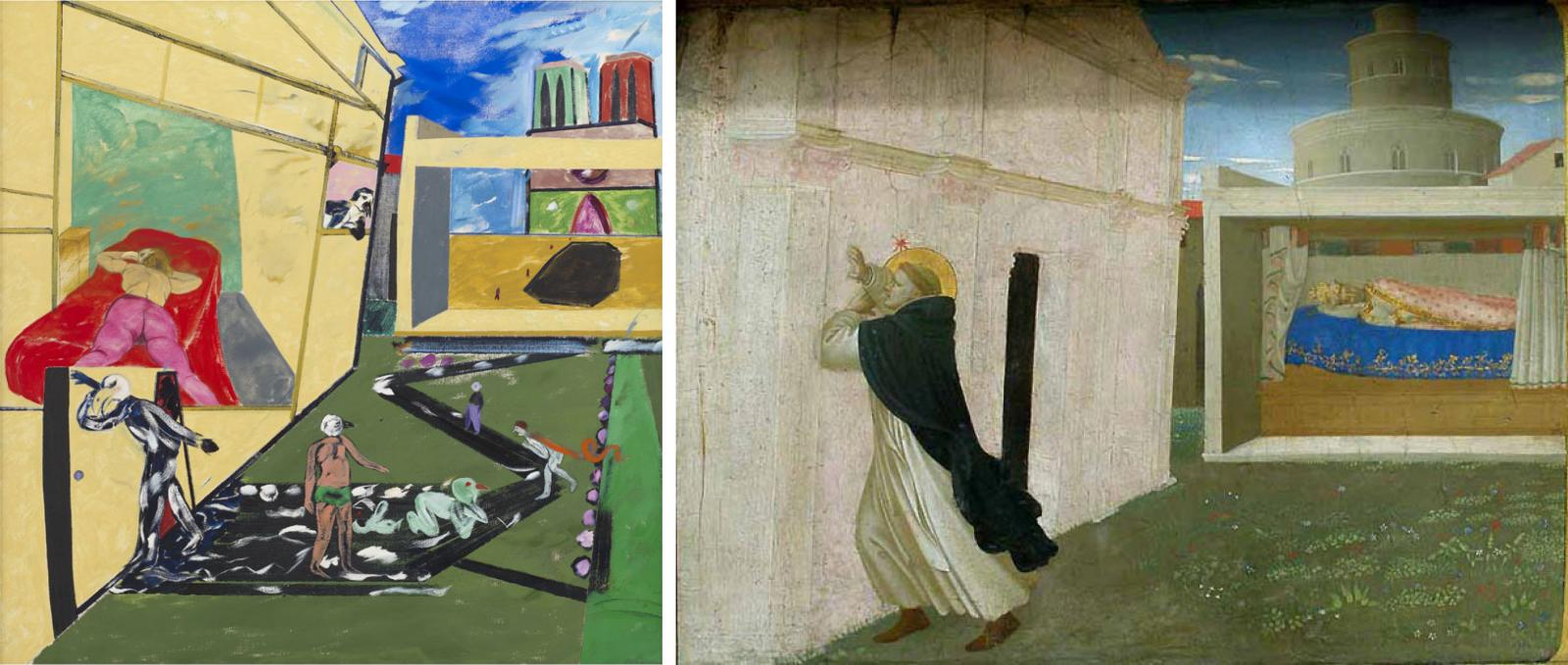
1 | Ronald B. Kitaj, Notre Dame de Paris, oil on canvas, 152,4x152,4 cm, 1984-1986, UBS Art Collection, New York.
2 | Beato Angelico, Il sogno di Innocenzo III, tempera on panel, 213×211 cm, ca.1434-1435, Musée du Louvre, Paris.
The clear reference calls for a religiosity that appears devoided of its Christian references: its mysterious inhabitants, the “Birds Head” [Fig. 3] miniatures of the Haggadah – a genre of narration used in the Talmud and in some parts of the Jewish liturgy and Midrash of the fourteenth century – interact in the painting, inhabit it, walking along it through its obscure central walkway in the same way in which the painter travelled the city a few years before the creation of the work. Jewish depictions or bird-women by Max Ernst? [Fig. 4] Both and neither. The montage in Notre Dame de Paris presented as a Dialektisches Bild opens up slowly and lets itself be discovered as one becomes aware of some details of the painter’s life: from his admiration towards Jewish intellectuals to his obsessive associations with the Parisian prostitutes in Rue St. Denis, from the knowledge of fifteenth-century Italian Art up to the European Avant-gardes.
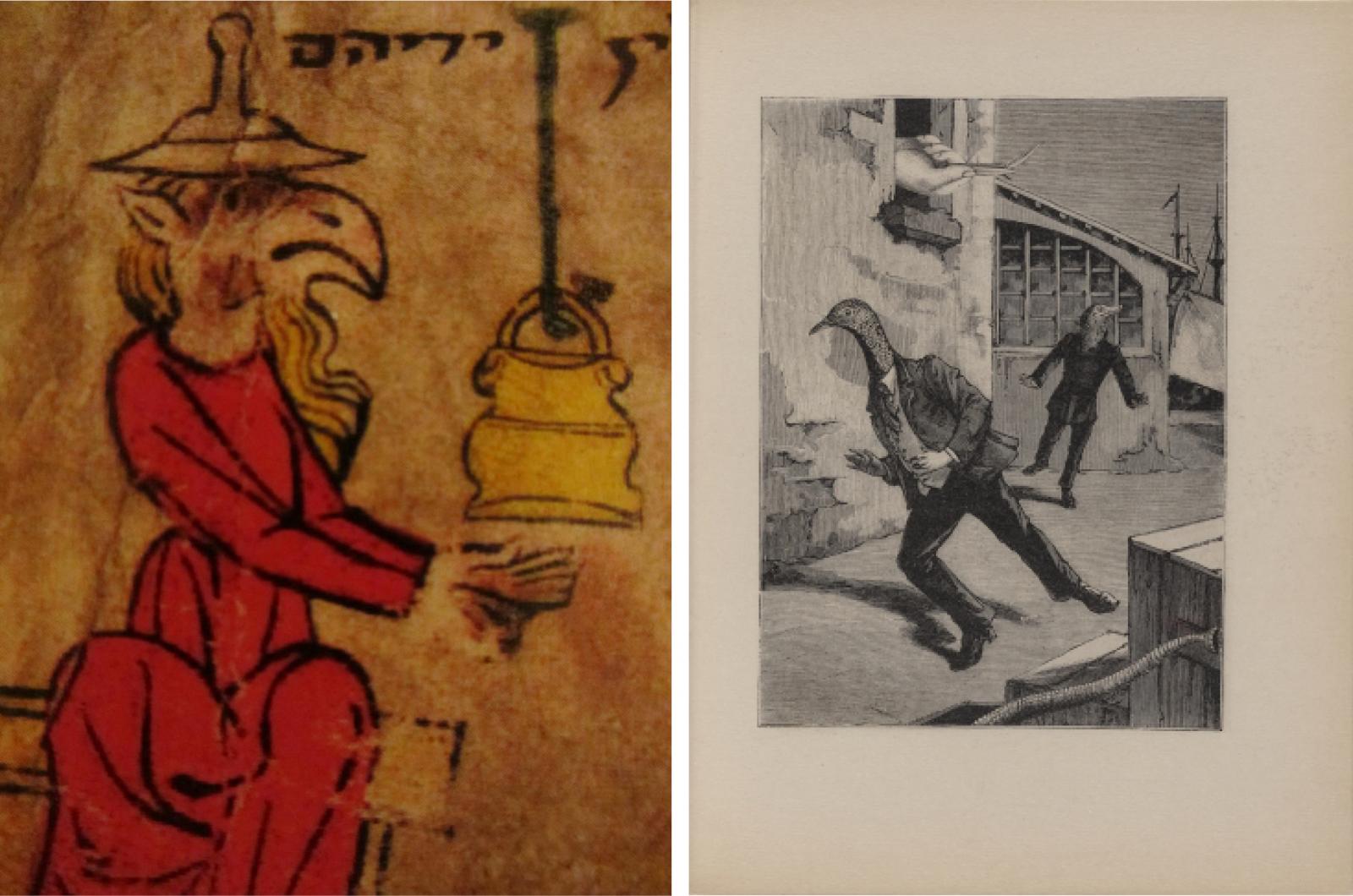
3 | Bird’s head Haggadah, 14th Century, details of an Illuminated Manuscript, ink and tempera on parchment.
4 | Max Ernst, The Robing of the Bride, oil on canvas, 130x96 cm, 1940-1941, Peggy Guggenheim Collection, Venezia.
The Bird Heads of the Jewish Kabbalah cross Rue St Denis from the cathedral to the large opening on the left side of the painting, where Karine – one of the painter’s favourite prostitutes – lies on a huge red bed. A new level of interlocking, a framework within a framework. The red bed, which recalls The Room (Rue St-Denis) [Fig. 5], frames the assembly mechanism, preventing the viewer from permanently stopping in a limited time and space. Notre Dame becomes the meeting point between the path of redemption and one that leads directly to lovers, between present and past, Christianity and Judaism, between Beato Angelico and Max Ernst, between the painter himself and Walter Benjamin: each detail seems to contribute to creating that anachronistic space so typical of the Paris Passage.
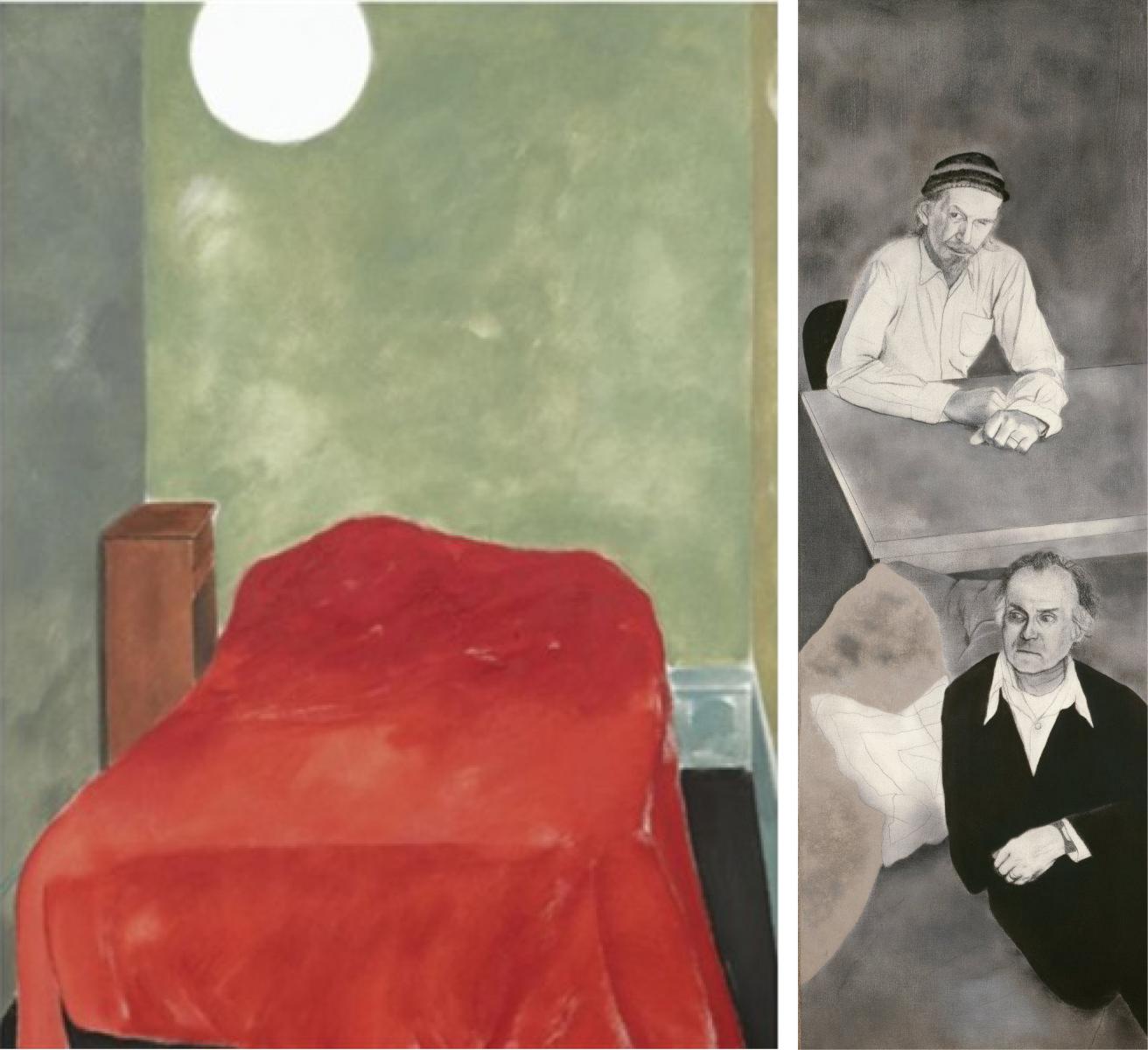
5 | Ronald B. Kitaj, The Room (rue St Denis), oil on canvas, 121,9x91,5 cm, 1982-1983, Marlborough Fine Art, London.
6 | Ronald B. Kitaj, A Visit to London (Robert Creeley and Robert Duncan), oil and charcoal on canvas, 182,9x61 cm, 1977, Museo Thyssen-Bornemisza, Madrid.
Confessions of an Old Jewish Painter together with a The Human Clay, An exhibition selected by R.B. Kitaj (Kitaj 1976), the introduction to The Artist’s Eye. An Exhibition selected by R.B. Kitaj at the National Gallery London (Kitaj 1980), Jewish Art – Indictment & Defence: A Personal Testimony by R.B. Kitaj (Kitaj 1984), Kitaj, Brief aus London (Kitaj 1988), First Diasporist Manifesto (Kitaj 1989), Drancy (Kitaj 1989), Second Diasporist Manifesto (A New Kind of Long Poem in 615 Free Verses) (Kitaj 2007), and lots of commentaries that Ronald Brooks Kitaj used to hang next to his paintings constitute the textual corpus the painter directly delivered to us on his work, his analysis, and his own interpretation of issues related to history of art.
According to his Los Angeles assistant Tracey Bratley, Confessions of an Old Jewish Painter was written by the artist in his favourite café, “Coffee Bean”, with red ink on yellow-lined paper every morning between six and ten o’clock from 2001 to 2003. In 325 pages divided into 35 chapters, it examines his life from his childhood in Cleveland to his exhibition “Los Angeles Pictures” (May 21-July 5, 2003) in the L.A. Louver Gallery.
On his work as a sailor and his trips to South America, his studies in New York (Cooper Union Institute), in Wien (Academy of Fine Arts), London (Ruskin School of Drawing and Fine Art, Oxford), Paris, Catalona, Hamburg, Madrid, Oslo, Hannover, his participation in Documenta 3 (1964) and The Venice Biennale (1964), his first marriage to Elsi Roessler (1953), second marriage to Sandra Fisher (1983), his retrospective at London’s Tate Gallery (1994), the so-called Tate War, Sandra’s death (1994), his Golden Lion at the Venice Biennale (1995), his years in Los Angeles, and on the many prostitutes, books, artists, essays, friends [Fig. 6] and works, Kitaj does not spare details, commenting on what has been an intense life full of recognitions and criticism, a polar oscillation where “Magic and Logic grow on the same stem”.
The unfinished and unpublished typescript titled Confessions of an Old Jewish Painter was found by his future editor Eckhart J. Gillen in the so-called “Kitaj Papers”, the literary estate of the artist stored in the Center for Jewish Studies at the University of California, Los Angeles (UCLA) among the thousands of letters, postcards, newspaper cuttings, visual sources, and manuscripts to his painting. In addition, another sixty-two pages, discovered in the unpublished archive of Kitaj Papers, recreate the rest of his life, from November 2003 to March 1, 2007, eight months before his suicide with this conclusion: “Failure, Failure as always! Desperation. My Jewish profile still life may be going to my usual nowhere”.
The amount of archive material, not only pictorial or graphic but also textual, as well as his huge interest in different kinds of literature, reveal an eclectic personality where word and image blend, weaving plots that are difficult to disentangle:
Books are for me what trees are for landscape painters... I do love books more than trees, flowers, lily-ponds, ballet, stripes, metal boxes, monochrome, fluorescent light, video trips, assorted junk, and so on and on…–.
The word enters the image as a figural element, e.g. Murder of Rosa Luxemburg [Fig. 7], or as an inseparable critique, e.g. Warburg Journal extract in the Catalogue Pictures with Commentary, Pictures without Commentary [Fig. 8], for his first Marlborough Gallery exhibition, London 1963.
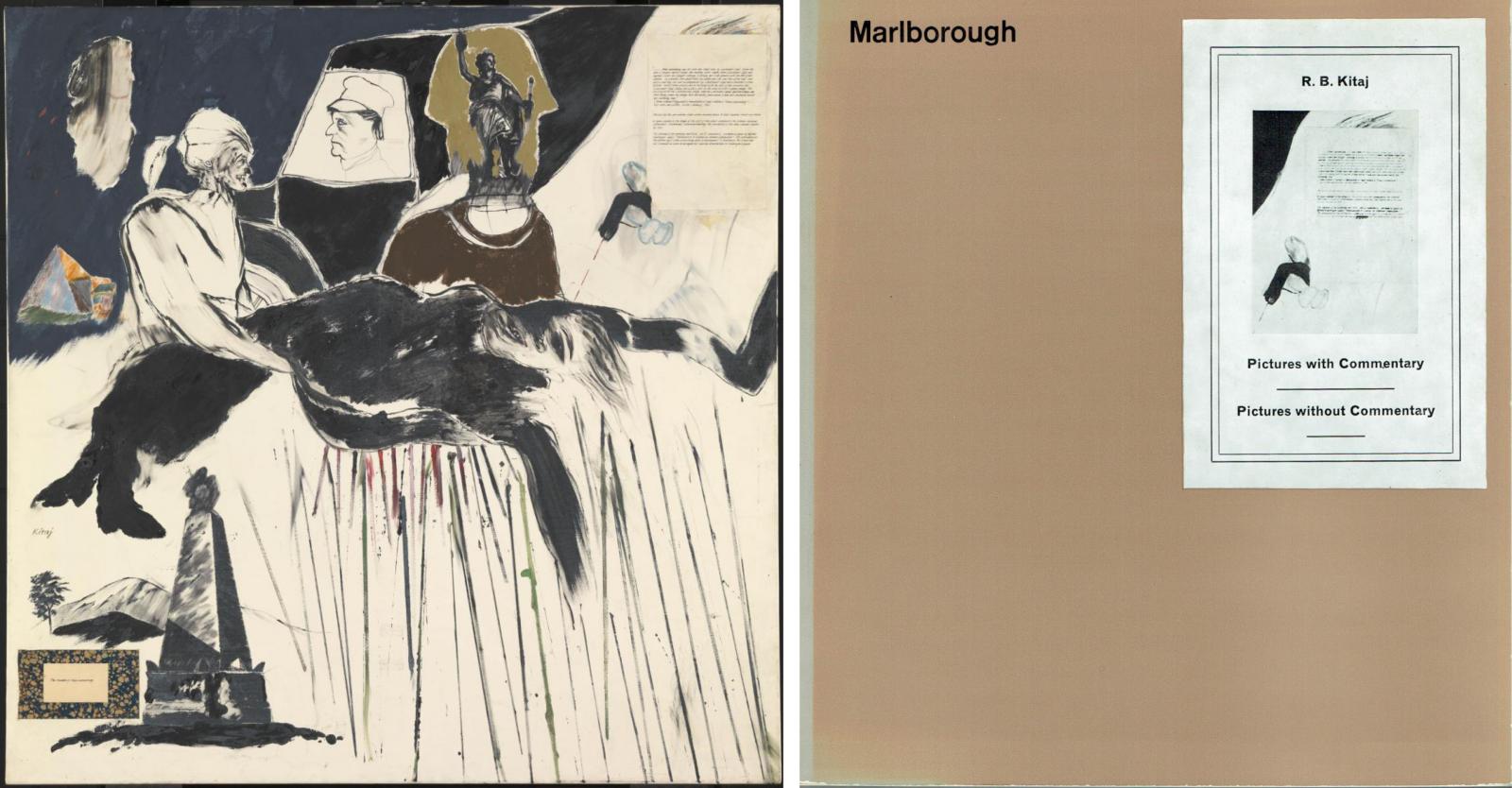
7 | Ronald B. Kitaj, The Murder of Rosa Luxemburg, oil and collage on canvas, 153x152,4 cm, 1960, Tate Gallery, London.
8 | Ronald B. Kitaj, Cover of the first Marlborough Gallery exhibition catalogue, London 1963.
By emphasising the use of side notes, the painting acquires a different value to what we generally associate with common captions: they become a part that belongs to the picture by being simultaneously outside (physically) and inside (conceptually). More cryptic than explanatory, they articulate and complicate the image’s interpretation rather than dissolving and opening it. This assembling of heterogeneous elements, from whose juxtaposition the sense of the work opens up to a wider range of interpretations, calls for a strong reference to the method of production of sense at the base of Aby Warburg’s Bilderatlas. The painter himself counts Aby Warburg among his favourite masters and scholars. The change in the function generally associated with the caption is explicitly associated by the painter with the Jewish tradition of the commentary.
... and the Jewish tradition of attaching commentaries in the very margins of holy pages of their masterpiece got me excited to do the same thing right on my unholy paintings... I supposed no painter had ever included notes onto or beside paintings before...
At the same time, the image becomes the main tool for his thoughts. In this regard, it is sufficient to observe the sketch made on a paper handkerchief at the table of a bar in order to describe the spatial movements carried out throughout a lifetime [Fig. 9]: the size and position of the area associated with the name of a city are directly proportional to the qualitative and quantitative influence it has had on the life of the painter. The reciprocity and the interchange between image and word, moreover, aroused much criticism from the art world, above all modernist, which singled him out as being a ‘bookish’ and ‘literary artist’, describing his work as ‘Hemingway-Gauguin bullshit’. This perspective allows us to consider his two types of artistic production, the written and the mainly pictorial, as two aspects of the same ‘artistic Thought’ which is structured into two different media. Confessions of an Old Jewish Painter could be considered a good example of that. The contribution of the image – here used only as a document or illustration – is less visible than the examples above; however, if we delve into a more specific analysis of the book it is possible to find a strong analogy with the paintings.
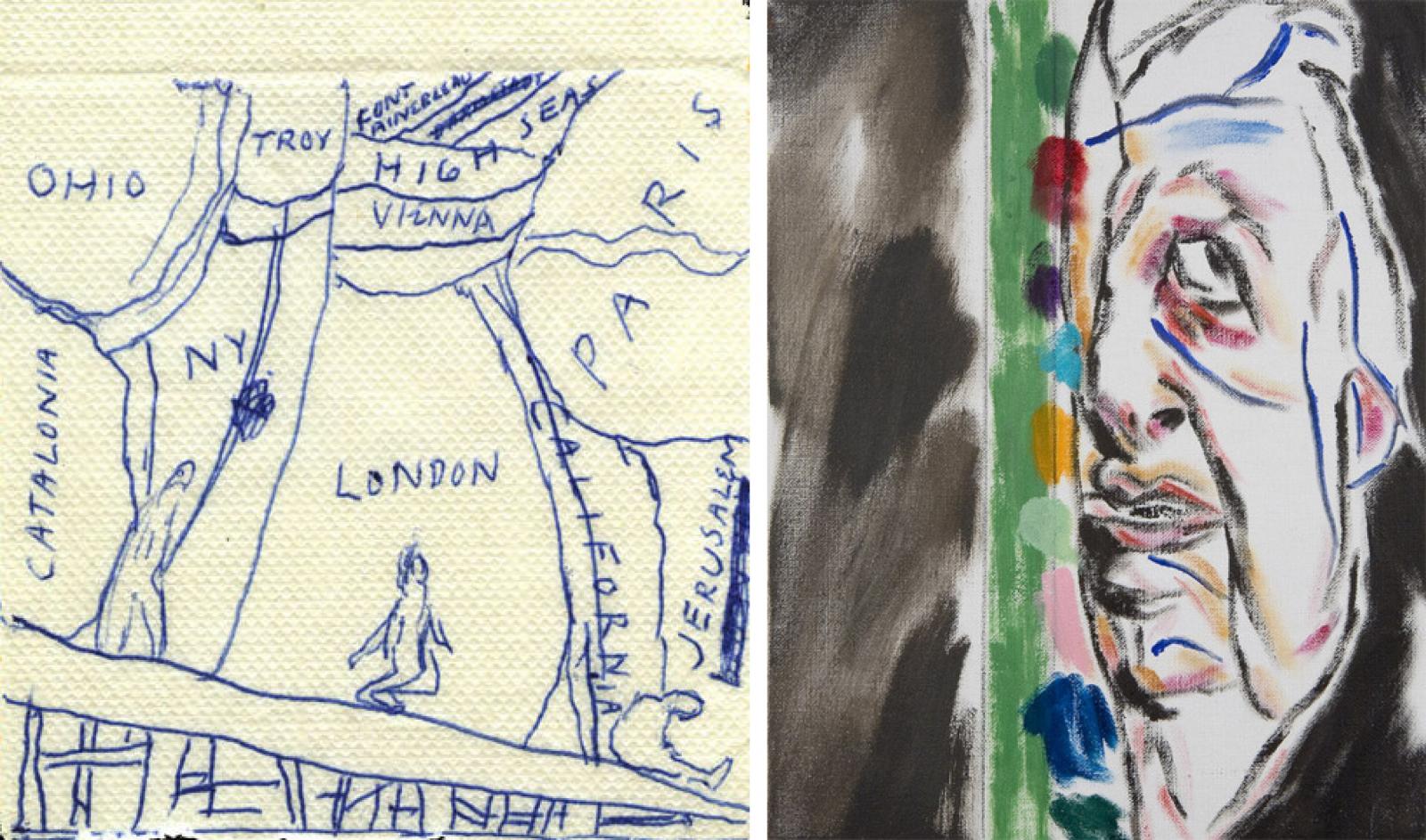
9 | Ronald B. Kitaj, sketch for My cities (An Experimental Drama) on a paper napkin in “Kitaj Papers”, University of California, Los Angeles (UCLA).
10 | Ronald B. Kitaj, Hannah Arendt in Jerusalem, oil on canvas, 35,6x27,9 cm, 2006, Collection of R.B. Kitaj Estate.
Confessions of an Old Jewish Painter is a book of confession
According to the editor, ‘Confessions’ could be interpreted as an allusion to the Confessions of the Church Father Aurelius Augustinus, St. Augustine, (354-430), who used the word for his autobiographical work about his path of redemption, from his sinful youth to his conversion to Christianity.
I was born on a Norwegian cargo ship called Corona slipping out of New York harbour at night, bound for Havana and Mexican ports in the summer of 1950... I would be born again and again as a Jew later on.
Just like St. Augustine, Kitaj describes his own tortuous path, full of errors and misunderstandings, towards the discovery of his own identity: a Diasporist Jew and a Diasporist Jewish artist. The Jewish question and the consequent search for what the editor calls a secular Judaism turns out to be one of the main topics of the text, structured as an actual path to redemption. It was triggered by Hannah Arendt’s report on the trial of Eichmann in Jerusalem [Fig. 10]. As he points out himself, his art shows what his mind did not understand from the very start: his Jewish being, an international fact that becomes the reason for his awareness. Although deeply spiritual, his Jewishness also embraces his choices in the field of art through the triangulation of terms DIASPORA – JEWISHNESS – ART.
Confessions of an Old Jewish Painter is a Jewish confession
According to the editor, “the proud confessions of his ‘sin’, his passions and drives that he recollects without shame” could be connected to the Jewish understanding of sin as defined by Rabbi Adin Steinsaltz: not a moment of repentance and atonement but a dispute with God, an act of rebellion:
The sinner is one who will not obey, one who, on account of external or internal factors, refuses to accept the ‘sovereignty of heaven’ and prefers a different kind of rule, whether it be that of other men, other gods, or his own appetites.
Confessions of an Old Jewish Painter is a diary
Although it was entirely written between 2001 and 2003, the diary form has been called into question. The facts are reinterpreted, not simply annotated but reconstructed after many years. Despite its chronological dimension, the way in which it was written (every morning at six o’clock), references to the present, the repetitions of events through the same phrases, and the colloquial register allows the text to be read as though it belongs to the aforementioned genre.
7 September 2002: like many Jews, I’ve read a hell of a lot of Holocaust stuff, but today I read something I’d not heard before. In an old copy of Midstream... [or] Today, October 2002, I became 70! And I’m still a crazy old Jewish book guy...
Confessions of an Old Jewish Painter is a Bildungsroman
The development of the main character (R.B. Kitaj), his determination to evolve and embrace his Jewish heritage and his search for a state of equilibrium with the surrounding reality through the dialectical overcoming of a series of crises (the deaths of Elsi and Sandra, the “Tate War”), and his substantial questioning of the possibility of this reconciliation, make Kitaj’s autobiography a Bildungsroman:
Failure, Failure as always! Desperation. My Jewish profile still life may be going to my usual nowhere.
Confessions of an Old Jewish Painter is a manifesto
One of the threads that runs through the entire text obviously concerns the painter’s artistic corpus, his passion and retrieval of drawing as artistic practice, his search for a personal style that is at the same time also concretely and truly Jewish. The Jewish Question was for him closely connected to the artistic one:
The preposterous idea of a New Jewish Art excites, confounds, and seduces me and makes me feel as modern as each new day... if you prefer a shorter Answer to my Jewish Question/Jewish Art, the Answer is Mad Love (164-165).
The description of everyday life, meetings, readings, discussions with other artists thus contribute to defining his artistic practice, understood not as an expression of a style but as the definition of a new form of art, a Diasporist art, born from a “feeling of not-belonging, of being an outsider”. It is no coincidence that the figures that most define the model of the Diasporist artist are Aby Warburg and Walter Benjamin, whose names are continuously repeated like an anaphora. It is possible to see this text as a detailed MANIFESTO OF DIASPORIST ART.
Confessions of an Old Jewish Painter is a response to the “Tate War”
The criticisms triggered by his retrospective at London’s Tate Gallery in 1994, which was, otherwise, a public success, were so cruel and heinous according to Kitaj that the experience dubbed the “Tate War” became an obsession for him [Fig. 11].
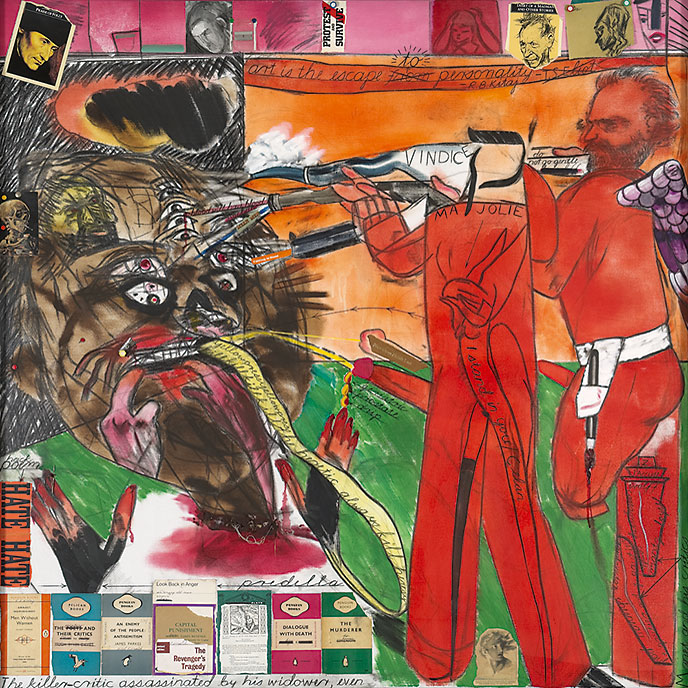
11 | Ronald B. Kitaj, The Killer-Critic Assassinated By His Widower, Even, oil and collage on canvas, 152,4x152,4 cm, 1997, Astrup Fearnley Museum for Modern Art, Oslo.
Confessions of an Old Jewish Painter is a testament to the Art of the late twentieth century
Last but not least, the text turns out to be a testament, a useful tool for a study of the art of the second half of the twentieth century, with particular attention to the central twenty years, the 60s-80s. An insight from the inside. The School of London and the London of the swinging 60s, the sexual revolution and feminist movement, the revival of figurative painting within pop art and the outsiders of London, Freud, Bacon [Fig. 12], Hamilton, Hockney [Fig. 13], the modernist dogma of art for art’s sake, Clement Greenberg, Rosalind Krauss, Arthur Danto, Alloway, the Warhol Factory, the quarrel with Jim Dine, the Eichmann case and the terrorist acts, the Israel-Palestine struggle and the Vietnam war. The personal relationships that Kitaj weaves into environments and personalities of the art and literature world give us glimpses of very personal and unique perspectives on the history of Western art.
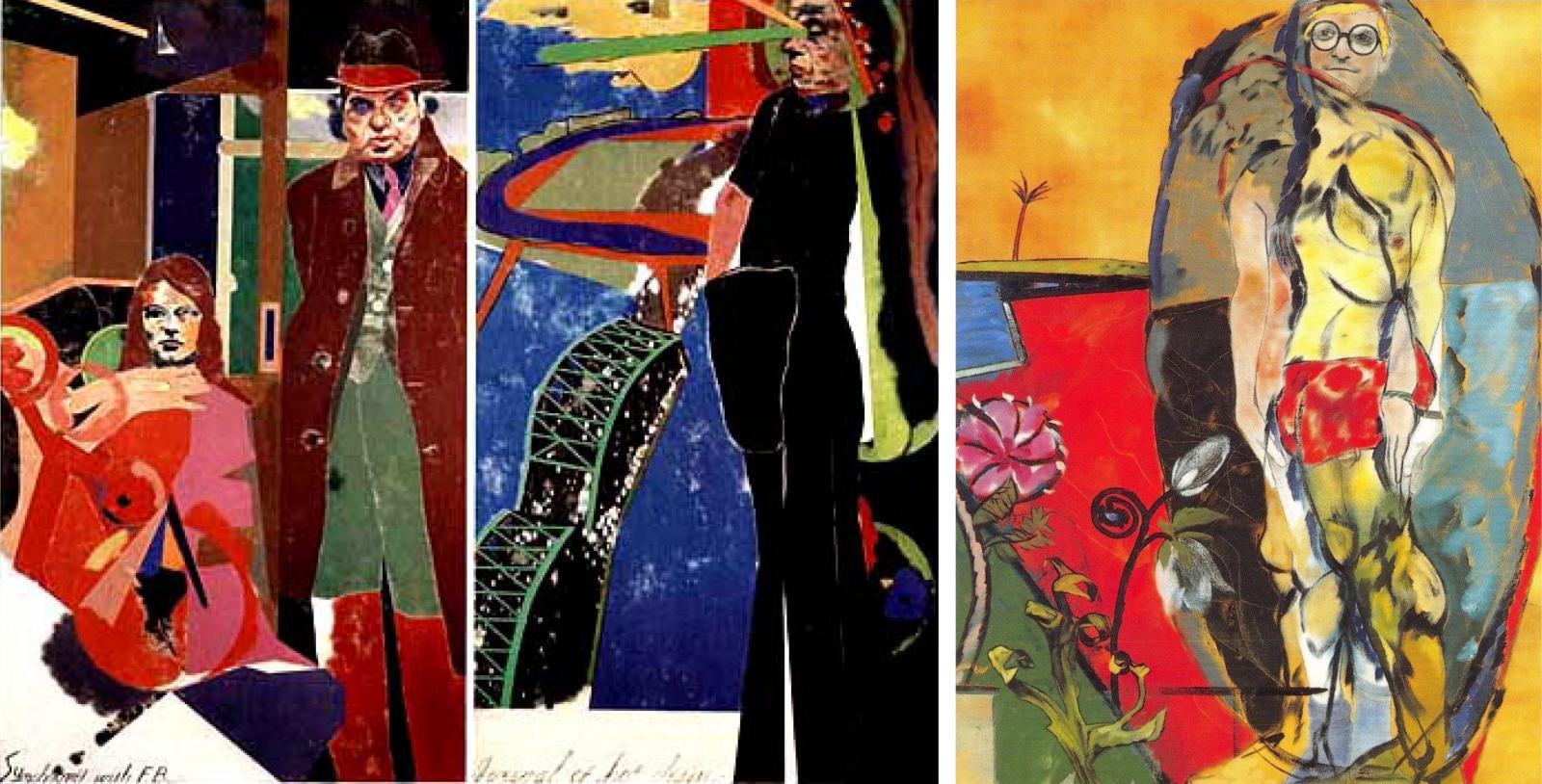
12 | Ronald B. Kitaj, Synchromy with F.B. General of Hot Desire, oil on canvas (diptych, left panel), each panel 152,4x91,4 cm, 1968-1969, private collection, London.
13 | Ronald B. Kitaj, The Neo-Cubist, oil on canvas, 177,8x132,1 cm, 1976-1987, Astrup Fearnley Museum for Modern Art, Oslo.
Confessions of an Old Jewish Painter is a diary, a manifesto, a Bildungsroman, a testament. No genre, no form prevails over the other. Genre and form are articulated and intertwined without cancelling each other, in a polar coexistence that finds no definitive solution. Juxtaposition and coexistence generate potential; the montage opens new ways of interpretation. So, as we reconnect to Notre Dame de Paris, we can see different materials, the montage-technique, and Kitaj’s tendency to combine heterogeneous features that create a productive tension – a passage through which Walter Benjamin meets Aby Warburg.
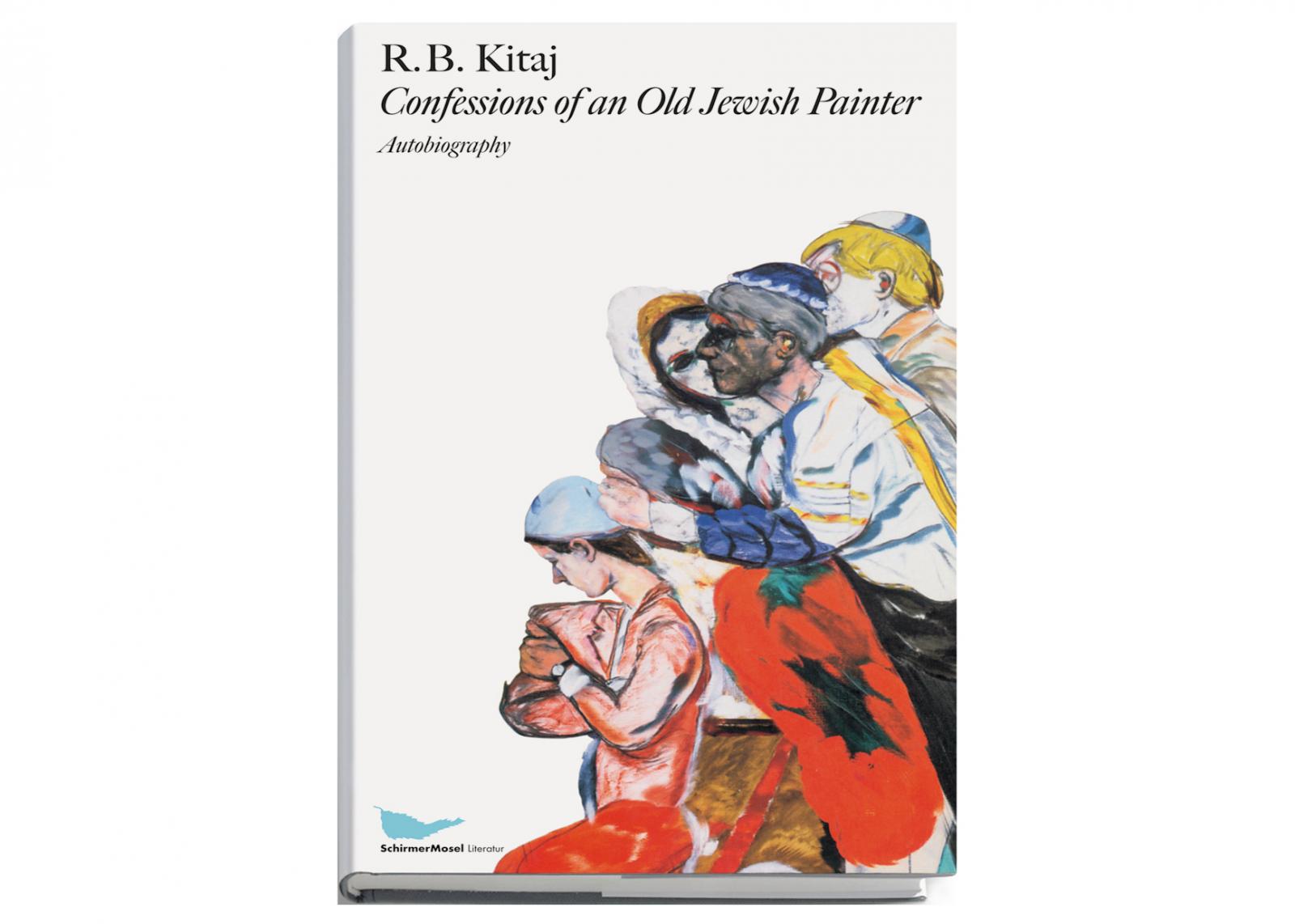
14 | Ronald B. Kitaj, Confessions of an Old Jewish Painter. Autobiography, Edited by Eckhart J. Gillen, Introduction by David Hockney, Schirmer/Mosel, München 2017.
On Kitaj as ‘Warburgian Artist’, see E. Chaney, R.B. Kitaj (1932-2007): Warburgian Artist, “emaj art journal” 7/1 (November 2013). See also, M.J. Nativo, A. Prati, Ronald Brooks Kitaj: Aby Warburg e Ernst Gombrich, due ritratti a confronto, “La Rivista di Engramma” 151 (November/December 2017).
English abstract
A diary, a manifesto, a Bildungsroman, a testament to the art of the Twentieth Century: Confessions of an Old Jewish Painter, Ronald B. Kitaj’s autobiography, left unfinished when the artist took his own life in 2007 in Los Angeles, describes the vices and sufferings of the artist. The book, a new form of biography, on the life of Kitaj, edited by E.J. Gillen follows the tradition of St. Augustine’s Confessions; different materials, the montage-technique, a tendency to combine heterogeneous features that create a productive tension, a passage through which Walter Benjamin meets Aby Warburg. The book, published for the first time in Germany in November 2017, is an opus mirabile from both a literary and artistic point of view.
keywords | Confession of an Old Jewish Painter, Kitaj, autobiography, Aby Warburg, Walter Benjamin.
To cite this article: M.J. Nativo, A. Prati, Ronald B. Kitaj, Autobiography of a Warburgian Artist. Review of: Ronald B. Kitaj, Confessions of an Old Jewish Painter, Edited by Eckhart J. Gillen, Schirmer/Mosel, München 2017, “La Rivista di Engramma” n. 153, febbraio 2018, pp. 213-224 | PDF